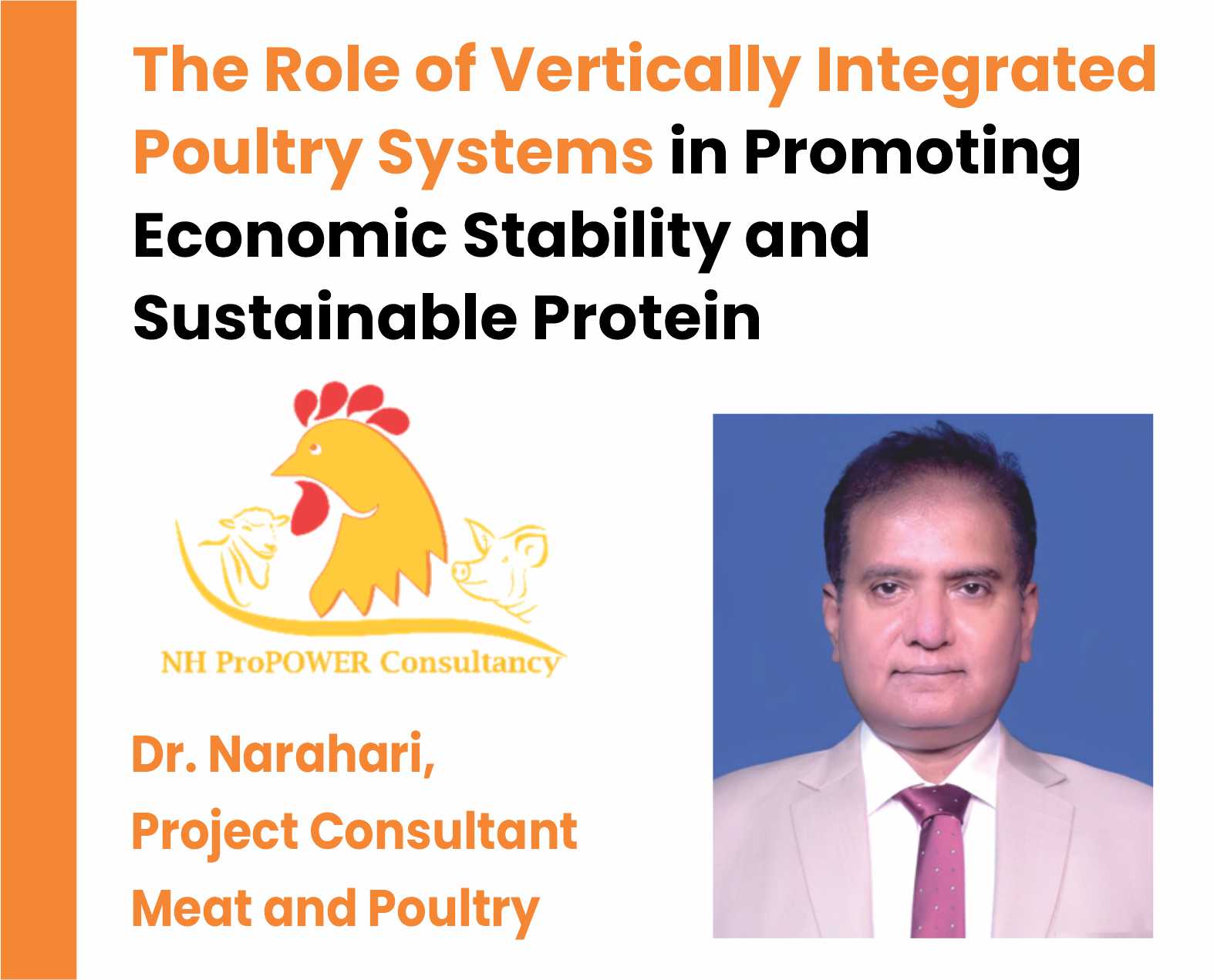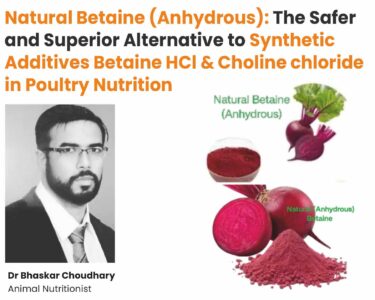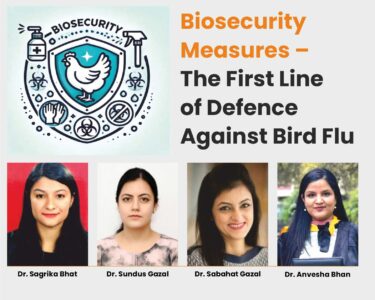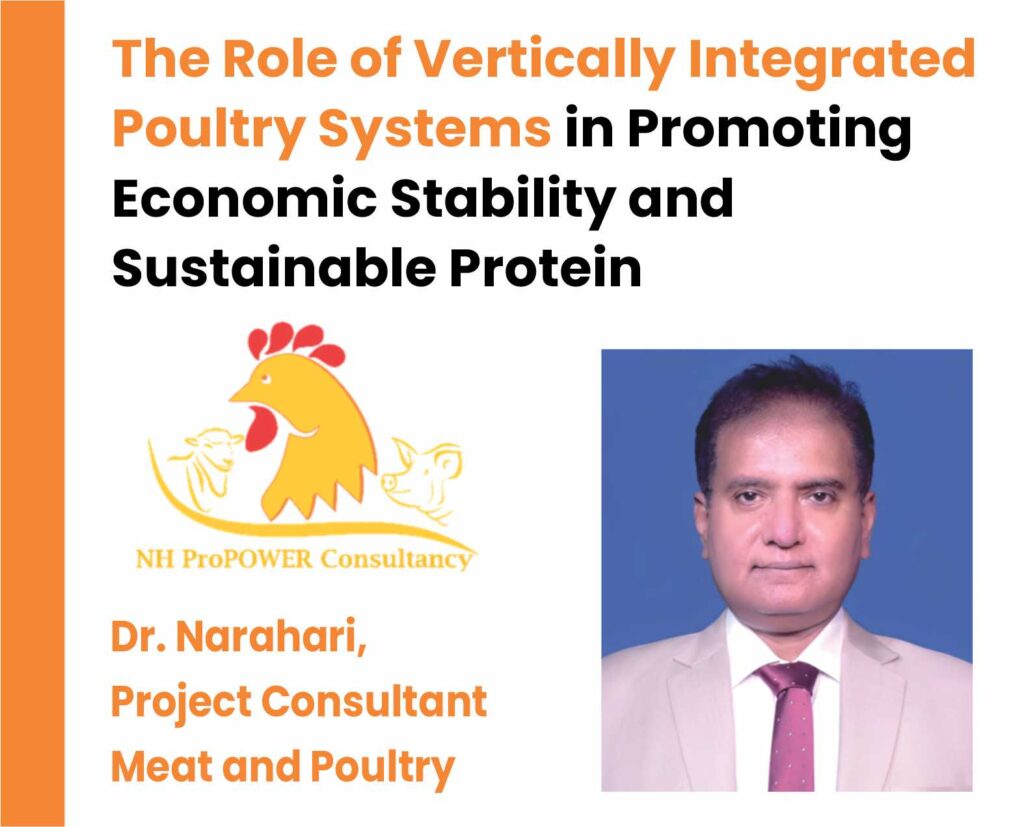
Dr. Narahari, Project Consultant – Meat and Poultry
Founder, NH ProPOWER Consultancy Services,
Bengaluru, Karnataka, +91 96633 76040, drnarahari@nhpropower.com
Introduction
The poultry industry makes significant contributions to our economy. It was the first livestock sector to industrialize. India is currently the third-largest producer of eggs (122 billion eggs) and the fifth-largest producer of chicken (4.4 MMT) (Gulati and Juneja, 2023). In the early days of the poultry business, the various stages and components, like feed manufacturers, hatcheries, grow-out farms, processing plants, and logistics, were functioning independently in markets while depending on each other to sell their products or services. Eventually, these related businesses within the poultry industry began to integrate and function as a single system. Vertically integrated poultry farming is a comprehensive approach that unifies all stages of poultry production (breeding, hatching, feed production, farming, processing, and distribution) under one umbrella.
Figure 1. Schematic representation showing typical operation of a vertically integrated poultry system+
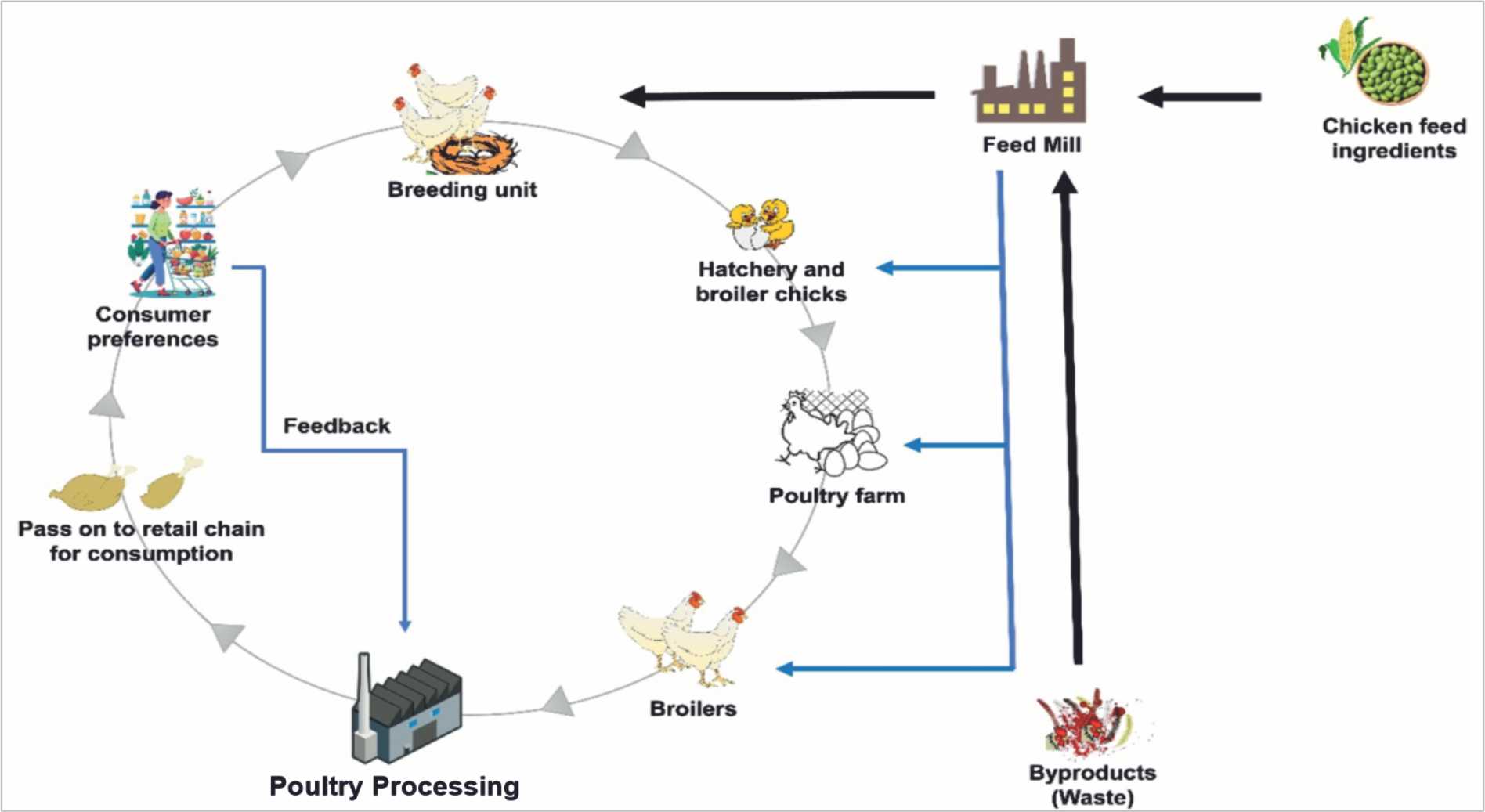
Figure 1 shows the typical operation of a vertically integrated poultry farm and processing unit. The vertical integration model, which incorporated large industry players and small farmers through a contract farming approach, emerged in the middle of the 20th century. This type of contract approach catalyzed the sudden growth of the poultry industry. Integrating different stages of poultry production through strong and modern processes and technologies promotes sustainability, affordability, and economic growth while ensuring quality throughout the supply chain. Streamlining every stage of the supply chain, fostering innovations and technologies, and reducing reliance on external suppliers are the key components of a successful vertically integrated poultry farming system. This article discusses the significance and potential of vertical farming in providing high-quality animal protein at affordable prices to meet the increasing demand for protein sources without compromising sustainable production practices.
Promoting Ethical Standards
Promoting ethical standards in a vertically integrated poultry system is crucial for humane and eco-friendly practices. Adopting and maintaining ethical standards entails supervising each phase of production, from breeding to processing, to assure compliance with improved welfare standards. Humane treatment covers sufficient space, appropriate feed, and healthcare for chickens. Specifically, in the vertically integrated poultry business, large organizations are instrumental in various levels of interconnected activities. With corporations’ business-oriented approach, the rearing conditions of poultry at breeder farms and commercial farms will be more sophisticated, ensuring humane and environmentally friendly practices. In addition, these corporations adopt ethical standards as promotional tools for selling their processed products. Here, cage rearing of birds shifted to floor-rearing practices, keeping poultry birds in more spacious ground areas rather than in cages. This practice provides the birds ample space to express their behavioral needs, like stretching wings, foraging, dust bathing, and ample time to move around. This shift in rearing space improves the birds’ health. It reduces their stress, increasing the productivity of good-quality meat and eggs . Maintaining bird density following European Union norms (33 kg broilers/m2) or Bureau of Indian Standards (floor space allocation, 0.3 to 1.0/square feet) reduces the risk of overcrowding and ensures the welfare of birds (Giersberg, Hartung et al. 2016).
Furthermore, ensuring ample feed and water availability at all points in a poultry system is critical for maintaining the birds’ optimal health, growth, and productivity. According to standards set by organizations such as the National Research Council (NRC) and the World Organization for Animal Health (WOAH), poultry feed should be balanced with the necessary nutrients. The diet typically contains 18-20% crude protein for broilers during the starter phase (0-3 weeks) and 16-18% during the grower phase (4-6 weeks).
Additionally, the quantity of feed provided differs according to the age and type of rearing. It is observed that during the initial six weeks of the rearing period, broiler chickens typically consume around 1.8-2.2 kg of feed, while layers consume about 110-120 grams of feed per day once they begin laying (Pal, Prakash et al. 2020). Importantly, feed should be stored properly to ensure that it is free from contaminants and toxins, particularly mycotoxins, which are secondary metabolites produced by fungi, and can be detrimental to poultry health. Additionally, a vertically integrated poultry system ensures residue-free and microbiologically safe meat by adopting stringent prophylactic and therapeutic measures at both breeding centers and farm units. Also, regular biosecurity protocols, such as footbaths, controlled access to facilities, and stringent sanitation practices, are essential to prevent pathogen introduction and spread. Besides, it is crucial to provide nest boxes for natural egg laying in breeder rearing to maximize egg production and ensure the well-being of the birds. Nest boxes provide a regulated setting that promotes hygienic and secure egg laying, enhancing the quality of eggs and their potential to hatch successfully. Nest boxes must be at least 12 x 12 inches per hen and should be placed at a suitable height to prevent floor laying (Graham 2024). These boxes for laying eggs relieve stress, encourage innate instincts, and simplify the process of harvesting eggs. In addition, they enhance egg cleanliness and enable more effective health monitoring, hence increasing productivity and adhering to humane standards. Collectively, adoption of above-mentioned standards/measured ensure the health and productivity of chickens and pay way for the sustainable and ethical farming practices.
Streamlining Resource Allocation
Optimizing resource allocation in a vertically integrated poultry system improves operational efficiency, lowers expenditures, and enhances productivity.
The adoption of this system maximizes resource allocation by optimizing the utilization of feed, water, and energy, hence decreasing wastage. Centralized planning and a coordinated supply chain are integral parts of a vertically integrated poultry business. These allow better forecasting and a seamless flow of materials into and from the system, reducing bottlenecks and delays in delivery. Further, integration ensures efficient utilization of floor space in rearing units, by optimizing designs of poultry houses and layouts, while adhering to animal welfare guidelines. Feed management (nutritious feed in the right quantity at the right time) using advanced automated feeding systems with appropriate designs reduces feed waste and improves the feed conversion ratio (FCR). Furthermore, waste products from one stage of production can be repurposed for another use (byproduct utilization). Generation of biogas and fertilizer from poultry litter and animal feed ingredients (meat and bone meal) from all non-edible poultry offal from slaughter plants can be well utilized to reduce waste and create additional revenue streams. For instance, eggshells can be processed into calcium supplements for animal feed or as soil conditioners (Gul, Shoqer et al. 2024) , dead chicks and birds may be converted into protein meal for animal feed, or biogas can be produced using strict biosecurity protocols. Interesting, innovative practices such as in-ovo sexing can reduce the number of male chicks hatched, and those that are hatched can be used in feed production or other industries (Jia, Li et al. 2023). Appropriate treatment of effluents from poultry operations using advanced wastewater systems, and water recycling are inevitable in vertically integrated poultry firms.
Further, during chicken processing, sludge can be processed into organic manure, providing a valuable agricultural resource, and reducing waste disposal issues. Moreover, transitioning from water-based chilling systems to air-based ones considerably lowers water use. Air chilling preserves meat quality by minimizing the uptake of water. Previous reports suggests that air chilling potentially delay the dominance of spoilage organisms Pseudomonas spp as it pays way for diverse microbiome (Belk, Duarte et al. 2021). Additionally, implementing water-saving technologies and practices such as high-pressure, low-volume cleaning systems reduces the use of water resources in vertically integrated poultry farming. Besides, incorporating water-saving technology and techniques, such as high-pressure, low-volume cleaning systems, decreases the use of water resources during chicken processing. Thus, integrated systems push for energy-efficient technologies and invest heavily in securing those technologies, which reduce overall energy consumption. For example, radiant heaters, which deliver direct heat to birds, and Heat recovery systems that capture and reuse waste heat from ventilation, reducing the unit’s energy needs. Also, rooftop solar panels provide a renewable energy source, decreasing reliance on non-renewable electricity. Also, automated feeding and drinking systems ensure precise feed and water delivery, reducing waste and energy consumption. Next, the utilization of centralized collected data, predictive analyses, and internet technologies facilitates data-driven decision-making, hence enhancing the business intelligence of a vertically integrated business model. The utilization of centralized collected data, predictive analyses, and internet technologies facilitates data-driven decision-making, hence enhancing the business intelligence of a vertically integrated business model. In addition, staff skill upgradation and education play a critical role in sustainable farming and production. Thus, educating staff on proper bird, product handling, and hygiene improves resource efficiency. Additionally, bulk purchasing, shared infrastructure, quality standards, traceability, and sustainability initiatives lower capital and revenue costs. Therefore, the adoption and upgradation of energy efficient technologies, data-driven decision-making, and waste management contribute to more eco-friendly and cost-effective poultry operations.
Delivering production efficiency and nutritional excellence
Vertical integration in poultry farming and processing promotes the production of superior animal protein that is accessible to consumers at reasonable prices. Here, the approach greatly reduces the life cycle of chicken products, reducing the time from breeding to market-ready chicken. This acceleration is essential for satisfying consumer demand, maintaining a steady supply, and preserving product freshness. Basically, it facilitates efficient resource management, shortens the life cycle of poultry, reduces overhead charges, achieves economies of scale, ensures consistent quality control, enables the adoption of new technologies and processes, and streamlines the distribution channels. This approach controls all stages of production, where it reduces bottlenecks and the wastage of resources like feed, water, and energy. Also, its centralized planning, efficient operations, and the procurement of inputs in large quantities result in reduced production costs, enabling the protein to be offered to customers at a more affordable price. For instance, vertical integration ensures that chickens reach market weight more quickly, typically within 35 to 42 days, compared to longer periods in less integrated operations (Wilcox, Sandilands et al. 2024) . Also, FCR can be improved to as low as 1.5 to 1.7 (Gulati and Juneja 2023 . Further, organizations with vertical integration can efficiently process up to 13,000 birds/hour. This efficient processing capability guarantees that chickens are slaughtered and processed promptly upon reaching their optimal weight, decreasing the time it takes them to go from the farm to the table. This type of shorter life cycle allows for more frequent production cycles and faster response to market demand. Moreover, the vertically integrated approach is defined by large-scale operations, which allows it to take advantage of economies of scale, reducing the cost per unit of production. This comprises reductions in expenses related to feed, equipment, labor, and other associated costs. Besides, it eliminates the obstacles of multilevel middlemen and assists in streamlining logistics (Begum 2005, Bamiro and Shittu 2009).
Nutritionally, poultry products are rich in high-quality proteins with fewer calories than red meat products. They contain essential vitamins like A, D, E, K, C, and B and minerals such as iron, calcium, magnesium, zinc, potassium, and Selenium. These nutrients are readily absorbed by the body, enhancing the nutritional value of the poultry products. Proteins in chicken products are easily digestible animal protein compared to other livestock proteins. It contributes to muscle growth and overall health in humans. Vertical integrated companies maintain consistency in their products by overseeing breeding, feeding, processing, and distribution, thus increasing consumer trust and satisfaction. Moreover, precision nutrition by adequate feed formulation based on the specific needs of poultry at different growth stages and environmental conditions enhances feed efficiency, reduces waste, and ensures products are rich with nutrients. Vertically integrated firms effectively oversee their existing distribution networks, allowing direct delivery to a large number of retailers and direct customers. Comprehensive supply chain management minimizes distribution expenses, lowers the price increases linked to middlemen, assures a consistent flow of products, and improves the effectiveness and dependability of the supply chain. Therefore, implementing vertical integration within an existing business offers chicken products of exceptional quality at competitive prices.
Catalyst for local economic development, job opportunities and investment
The poultry industry began evolving in the 1930s and adopted a vertically integrated style of contract farming in the 1950s. Later in the 1980s, horizontal integrations were introduced, resulting in regional monopsonies in the poultry business (Constance, Francisco et al. 2013) . However, by integrating the different stages of production, the integrators reduced costs by coordinating the production capacity of each stage or component of the production system. The chicken industry has grown to a higher magnitude today by combining production stages into large vertically integrated firms that can take advantage of rapidly changing technologies and innovations. Generally, vertical integration involves contract farming or breeding, where large organizations contract local farmers to breed/raise chickens, providing them with chicks, feed, veterinary support, and technical guidance. This system creates a stable income source for farmers, who benefit from reduced market risk and guaranteed prices for their produce. By reducing the need for farmers to invest in costly infrastructure, such as feed mills or processing plants, vertical integration makes poultry farming more accessible and profitable for local communities. In India, 70% of poultry farmers engaged through contract farming are small farmers with a flock size of 3,000-10,000 birds; 20% are medium-scale farmers with 10,000- 50,000 birds, and only 10% are large-scale farmers with 50,000-400,000 birds (Khire and Ryba 2024). Additionally, the presence of vertically integrated poultry companies stimulates local economies through job creation. These companies require a workforce for hatcheries, feed mills, processing plants, and distribution networks, creating employment opportunities beyond the farm level. Investment in local infrastructure, such as roads and utilities, often accompanies these operations, further benefiting the community. This significantly increases the cash flows to rural areas. This provides a stable and profitable source of income within their communities, where individuals can maintain their agricultural heritage while incorporating poultry farming. This dual income stream enhances financial stability for rural families, encourages the retention of agricultural knowledge, and sustains the social fabric of rural areas. The poultry industry is characterized by shorter cash flow cycles, ensuring farmers receive timely payments. This reliable income stream supports the day-to-day financial needs of rural families, enhancing their quality of life and enabling them to invest in education, healthcare, and other essential services. Income predictability also allows for better financial planning and reduces economic uncertainty for rural households. Additionally, jobs in transportation and logistics, further boost the rural economy. Other support services such as laboratories, workshops, warehouses, professional training, and other ancillary services create a diverse range of jobs in rural areas. Thus, vertical integration in poultry farming and processing significantly enhances the economic resilience and prosperity of rural areas.
Production sustainability
The concept of sustainability in a vertically integrated poultry business is regarded as multi-dimensional. The term sustainability encompasses economic, environmental, social, and institutional governance aspects . The output of sustainable production is maximizing the delivery of safe and nutritious food per unit of input resource without increasing pressure on land . Implementing energy-efficient technologies and practices at every production stage reduces overall energy consumption. For example, LED lighting, energy-efficient ventilation systems, and high-efficiency heating systems can lower the energy required for poultry housing and processing. Renewable energy sources, such as solar energy, wind energy, biogas, etc., can provide a significant portion of the energy required in the poultry industry. Installing solar panels on farm buildings and processing facilities, installing wind turbines to generate electricity for farm operations (in areas with consistent wind patterns), and utilizing agricultural by-products and waste materials as fuel for boilers and heating systems reduces waste and reliance on conventional fossil fuels. Apart from these, space utilization is optimized by setting up advanced housing systems, including multi-tiered aviaries. These systems enable the housing of a greater number of birds in a single location without compromising animal welfare, thereby reducing the overall land footprint of poultry operations. On the other hand, adoption of nipple drinker system reduces water wastage by preventing spillage and evaporation. Additionally, the transition from immersion to air chilling during refining enhances energy efficiency and reduces water consumption. Additionally, air chilling offsets the risk of cross-contamination and improves the quality of the final product by preserving a more natural flavor and texture. Similarly, vertical integration involves adopting water reclamation systems to decrease water consumption and heat recovery systems that harvest waste heat produced during processing and redeploy it to heat water and power equipment or maintain facility temperatures. Together, these practices in vertically integrated units reflect the organization’s commitment to environmental stewardship while maintaining high productivity and economic sustainability (Figure 2).
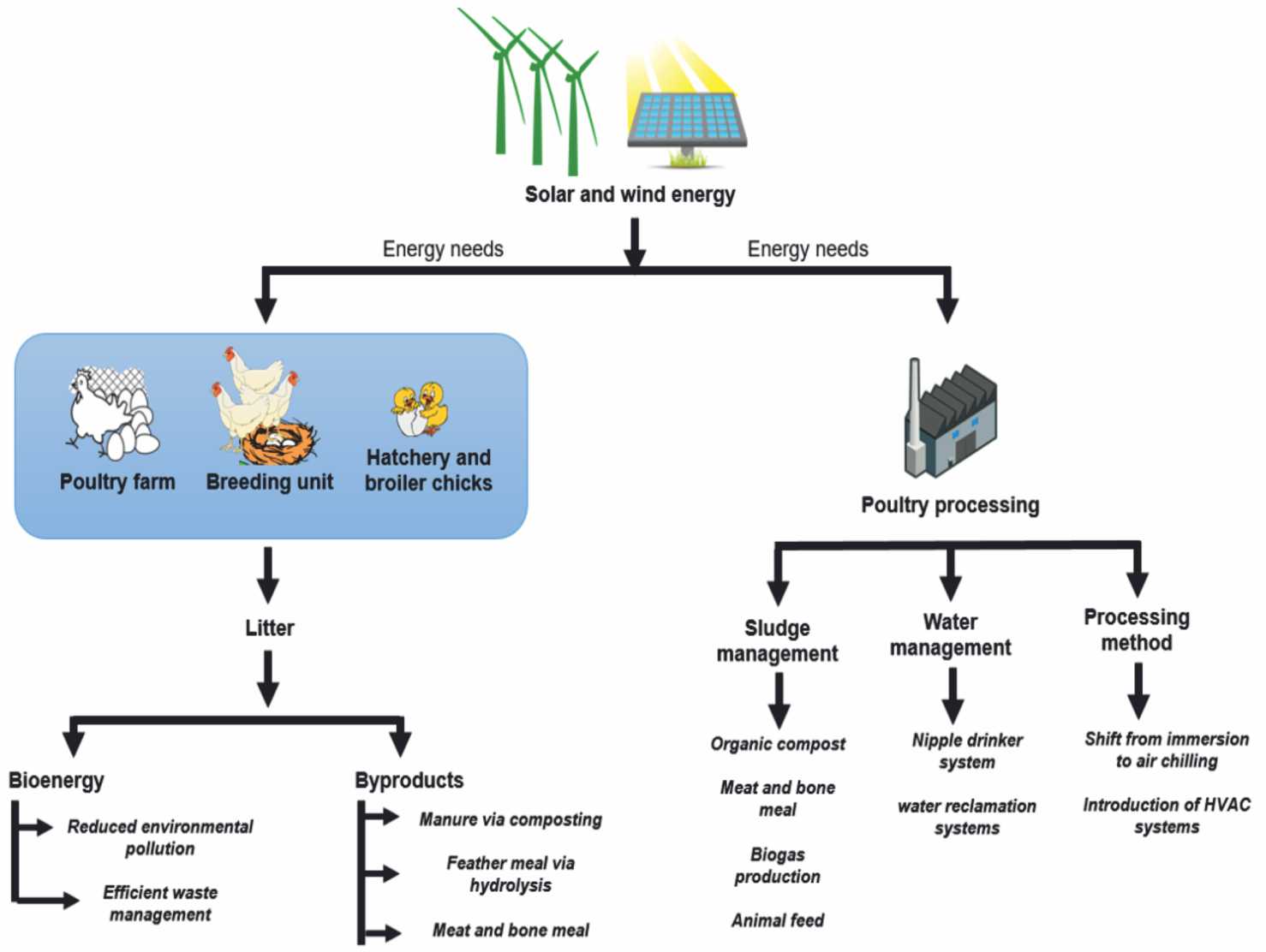
Figure 2. Schematic representation of sustainable practices employed in vertically integrated poultry farms and processing units. The figure highlights solar and wind energy use to meet energy needs across poultry farms, breeding units, hatcheries, and processing plants. Litter from poultry farms is converted into bioenergy and byproducts like manure, feather meal, and meat and bone meal, reducing environmental pollution. In processing, sludge is managed through organic composting, biogas production, and animal feed creation. Water management includes using nipple drinker systems and water reclamation, while energy-efficient processing methods like shifting from immersion to air chilling and introducing HVAC systems are employed to conserve energy and water resources.
Conclusion
In conclusion, implementing a vertically integrated poultry business model offers a sustainable, efficient, and cost-effective strategy for producing high-quality animal protein and products according to consumer preferences. This strategy involves centralized control over all phases of poultry production, from breeding and raising birds to processing and packaging the final products. By maintaining oversight at every step, companies can ensure that resources such as energy, water, and feed are used efficiently, minimizing waste throughout the production chain. Moreover, it integrates ethical practices and ecologically sustainable methods into production. Ethical practices include providing humane living conditions for the birds, such as adequate space, proper nutrition, and veterinary care, which collectively enhance animal welfare. Sustainable practices involve reducing the carbon footprint by using renewable energy sources like solar and wind power and recycling waste products into bioenergy or organic fertilizers. By focusing on these ethical and sustainable procedures, the poultry sector improves the overall health and well-being of the animals and enhances the quality of the products. Consumers receive higher-quality poultry products that are produced in an environmentally responsible manner, supporting both animal welfare and the health of the planet.
References are available on request.


